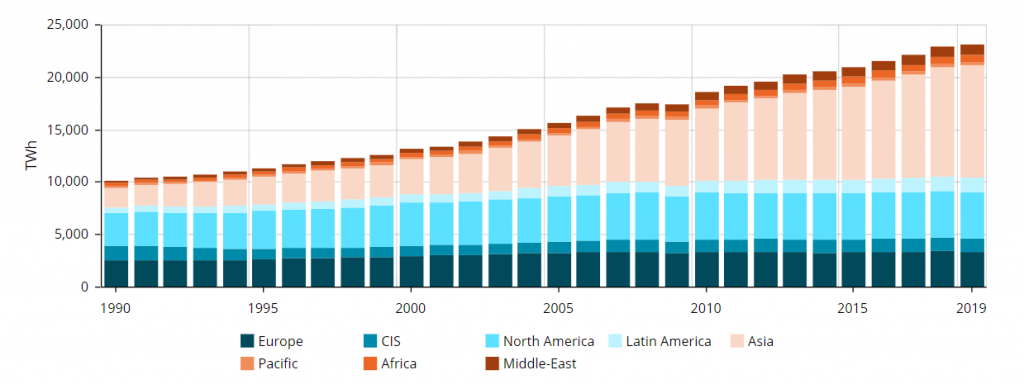Efficient Lighting
Social and technological development throughout the world has been, in a way, responsible for the evolution and improvement of the quality of life of societies worldwide. However, such development is based on a substantial and ever-increasing consumption of the planet’s energy resources (Energy, 2020).
A significant portion of this consumption is made with the purpose of producing electricity, which can be obtained from either renewable or non-renewable sources. Although electricity production from the former increases annually, so does the production from the latter in order to meet the increasing demand. This growth results in higher emissions of pollutants to the atmosphere which, combined with other aspects of human activity, contribute to climate change.

Figure 1 – Global evolution of electricity consumption (1990-2019) (Global Energy Statistical Yearbook 2020, 2020).
Lighting in electricity consumption
According to the IEA (International Energy Agency), about 19% of global electricity consumption refers to lighting systems, that number being around 14% in the European Union (Aníbal de Almeida, 2014). Considering that currently there are numerous lighting fixtures at the household, industrial or public lighting level that still use old and inefficient technology (e.g. incandescent lights), the potential for reducing consumption in this area is still significant.
In the next picture the distribution of electricity consumption for lighting purposes in different European sectors is shown:

Figure 2 – European electricity consumption for lighting per sector in 2007 (Aníbal de Almeida, 2014).
Regarding the industry, the impact of electricity consumption for lighting purposes of the monthly bill is highly variable, depending on the type of industrial activity, remaining nonetheless a considerable amount. When it comes to commercial and residential buildings, it can represent up to 17%. And considering municipalities, public lighting can represent up to 60-80% of their total electricity consumption (Rachel Dzombak, 2020). It is due to the high costs of lighting in the monthly electricity bill that the adoption of energy efficiency measures represents considerable savings potential.
The matter can be addressed in several manners, the following being the three main ones to increase efficiency (Khairul Rijal Wagiman):
- Replace/retrofit existing inefficient luminaires (e.g. incandescent lights) for others that use efficient technology (e.g. LED);
- Adjust the illumination level (using more efficient luminaires can lead to the reduction of the number of installed luminaires);
- Implementation of control systems (e.g. automatic lighting adjustment considering the space occupancy or the available natural light).
In the case of replacing inefficient equipment for LED technology, there are multiple advantages to benefit from (Aníbal de Almeida, 2014):
- Significant electricity consumption reduction, due to higher LED technology efficiency;
- Decrease of heat losses, possibly resulting in less need to resort to climatizing devices;
- Longer equipment life expectancy (LEDs can last between 25.000 to 50.000 hours, considerably longer than other technologies, and it is expected that time may increase in the future up to 75.000 hours (Andrei Nardelli));
- Low maintenance costs;
- Reduced light pollution;
- Wide range of colours;
- Scalable;
- …
One of the main and most frequently mentioned disadvantages of LEDs is its higher initial investment cost, however, the savings obtained from reduced energy consumption allow for a quick return of the investment made. Taking also into account the continuous decrease in price in the past years that accompanies the development of the technology, and its foreseeable evolution in the future, LED technology is increasingly becoming a viable option.
It is, however, of paramount importance that a project to implement an efficient lighting system follows an extensive study of the installation and its current condition. That will allow defining which is the best solution to be adopted taking into account the individual needs of each client. At TecnoVeritas you can rely on the experience of a devoted team of engineers to perform an energy efficiency study of your installation, proposing the best solutions in a personalized format and taking into account your individual needs, always aiming at maximizing your return on investment.
Bibliography
Andrei Nardelli, E. D. (s.d.). Assessment of Light Emitting Diodes technology for general lighting: A critical review.
Aníbal de Almeida, B. S. (2014). Solid state lighting review – Potential and challenges in Europe.
Cook, B. (s.d.). High-efficiency lighting in industry and commercial buildings.
Energy. (17 de 07 de 2020). Obtido de ourworldindata.org: https://ourworldindata.org/energy
Global Energy Statistical Yearbook 2020. (17 de 07 de 2020). Obtido em 15 de 07 de 2020, de yearbook.enerdata.net: https://yearbook.enerdata.net/electricity/electricity-domestic-consumption-data.html
Khairul Rijal Wagiman, M. N. (s.d.). Lighting system control techniques in commercial buildings: Current trends and future directions.
Rachel Dzombak, E. K. (2020). Exploring Cost and Environmental Implications of Optimal Technology Management Strategies in the Street Lighting Industry.




